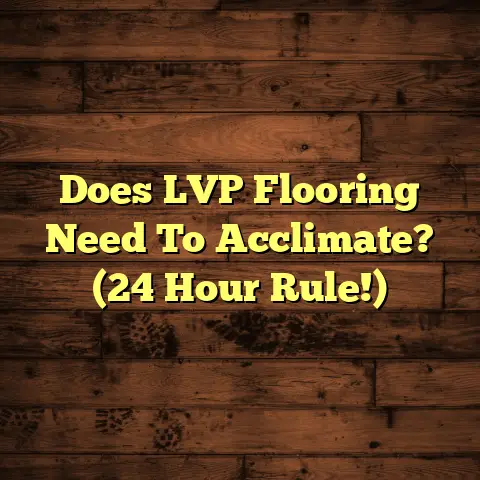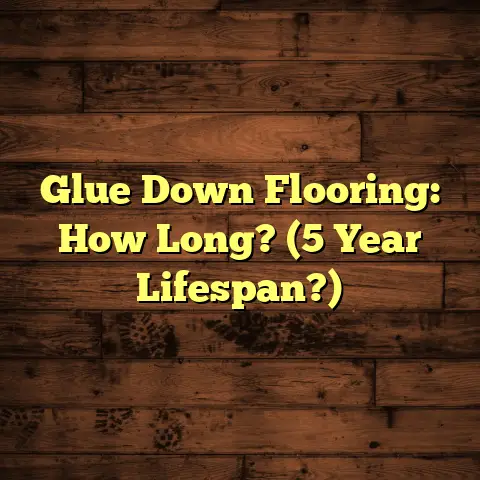Build a Floor Over Crawl Space? (1 Day DIY?)
Lately, I’ve noticed more and more homeowners are eyeing their crawl spaces, wondering if they can transform that dusty, forgotten area into something useful.
With the rise of remote work and the constant need for more living space, that crawl space is starting to look like prime real estate.
And let’s be honest, the DIY bug has bitten us all, right?
There’s nothing quite like the satisfaction of tackling a project yourself, saving some serious cash, and customizing it exactly to your liking.
So, can you actually build a floor over your crawl space in just one day?
The short answer is: it might be possible for some very skilled DIYers with a well-prepped space and a simple plan.
But for most of us, it’s more realistic to aim for a weekend project.
In this article, I’m going to walk you through everything you need to know to make this project a success.
We’ll cover the ins and outs of crawl spaces, planning your attack, prepping the area, installing the floor, and what to do after it’s all done.
Let’s get started!
Section 1: Understanding Crawl Spaces
Okay, first things first: what exactly is a crawl space?
Simply put, it’s the unfinished area between the ground and the first floor of your house.
Think of it as a mini-basement, usually just tall enough to, well, crawl around in.
Typical features include:
- Dirt or gravel floor: Most crawl spaces have a bare earth or gravel floor.
- Low ceiling height: Usually between 18 inches and 4 feet.
- Foundation walls: These support the structure of your house.
- Vents: Designed to provide some air circulation (more on that later).
- Pipes and wiring: Often running through the crawl space.
The Dark Side of Crawl Spaces
Crawl spaces often get a bad rap, and for good reason.
They can be breeding grounds for all sorts of problems:
- Moisture: This is the BIGGEST issue.
Moisture leads to mold, rot, and all sorts of structural damage. - Pests: Mice, rats, insects…you name it, they love crawl spaces.
- Accessibility challenges: Getting in and out can be a real pain (literally!).
- Musty odors: That damp, earthy smell that seeps into your home.
According to the EPA, up to 50% of the air in your home can come from your crawl space.
Yikes!
Why Convert Your Crawl Space?
Despite the potential downsides, there are some compelling reasons to consider converting your crawl space:
- Extra storage: A clean, dry crawl space can be a great place to store seasonal items, holiday decorations, etc.
- Play area: For kids, a finished crawl space can be a magical hideaway.
- Workshop: A dedicated space for your DIY projects.
- Increased home value: A well-maintained and usable crawl space can add to your home’s appeal.
Structural Considerations
Before you even think about laying down a floor, you need to make sure your crawl space is structurally sound.
This means:
- Checking for foundation cracks: Any significant cracks need to be addressed by a professional.
- Ensuring proper drainage: Water should be directed away from the foundation.
- Addressing any existing moisture problems: This is crucial!
You can’t build a floor over a damp crawl space.
Proper ventilation is also key.
While older crawl spaces often relied on vents, modern building science suggests that sealing the crawl space is often a better approach, especially in humid climates.
This involves encapsulating the crawl space with a vapor barrier and potentially adding a dehumidifier.
Section 2: Planning Your Project
Alright, now that we’ve covered the basics of crawl spaces, let’s get down to the nitty-gritty of planning your floor installation.
Measure Twice, Cut Once (and Then Measure Again!)
The first step is to accurately measure the dimensions of your crawl space.
I recommend using a laser measuring tool for this, as it will give you precise readings even in tight spaces.
- Length and width: Measure the longest and widest points of the crawl space.
- Height: Measure the distance from the ground to the bottom of the floor joists.
- Obstacles: Note the location of any pipes, wiring, or other obstructions.
Tools and Materials Checklist
Here’s a list of the essentials you’ll need for this project:
- Lumber: Treated lumber for framing (2x4s or 2x6s, depending on your needs)
- Plywood: Tongue-and-groove plywood for the subfloor (3/4 inch is ideal)
- Insulation: Rigid foam insulation or fiberglass batts
- Vapor barrier: 6-mil polyethylene sheeting
- Fasteners: Screws (exterior-grade) are preferred over nails for better holding power
- Tools:
- Measuring tape
- Laser level
- Circular saw
- Drill/driver
- Safety glasses
- Gloves
- Dust mask
- Staple gun
- Utility knife
One-Day Timeline: Realistic or Pipe Dream?
Okay, let’s talk about that one-day goal.
Honestly, for most homeowners, it’s a stretch.
A more realistic timeline would be a weekend project, broken down as follows:
- Day 1: Crawl space prep (cleaning, vapor barrier, insulation)
- Day 2: Framing and subfloor installation
However, if you’re a seasoned DIYer with a small, well-prepared crawl space, and you have a helper, it might be possible to pull it off in a single day.
Building Codes and Permits
Before you start swinging that hammer, it’s crucial to check your local building codes and permit requirements.
Modifying a crawl space often requires a permit, especially if you’re altering the structure or adding living space.
Contact your local building department to find out what’s required in your area.
Failing to obtain the necessary permits can result in fines and delays down the road, so don’t skip this step!
Section 3: Preparing the Crawl Space
Now for the not-so-glamorous part: prepping the crawl space.
Trust me, this is where you’ll spend most of your time and energy, but it’s absolutely crucial for a successful project.
Clear the Decks! (or Rather, the Dirt)
The first step is to remove any debris from the crawl space.
This includes rocks, branches, old insulation, and anything else that’s lying around.
I recommend wearing a dust mask and gloves for this task, as crawl spaces can be pretty grimy.
Leak Detection 101
Next, inspect the crawl space for any signs of leaks.
Look for water stains on the foundation walls, puddles on the ground, or any other evidence of moisture.
If you find any leaks, repair them before moving on to the next step.
This might involve patching cracks in the foundation, repairing leaky pipes, or improving drainage around your home.
Vapor Barrier Installation: Your Moisture Defense
A vapor barrier is a sheet of plastic that prevents moisture from the ground from entering the crawl space.
This is a critical step in preventing mold and rot.
- Lay the vapor barrier: Overlap the edges by at least 12 inches.
- Seal the seams: Use seam tape to create an airtight seal.
- Secure the edges: Run the vapor barrier up the foundation walls and secure it with construction adhesive or staples.
Insulation: Keeping it Cozy (and Energy-Efficient)
Insulating your crawl space will help to regulate the temperature and reduce energy costs.
There are two main types of insulation you can use:
- Rigid foam insulation: This is a good option for sealing the crawl space and providing a thermal barrier.
- Fiberglass batts: This is a more affordable option, but it’s less effective at sealing out air and moisture.
If you’re using fiberglass batts, be sure to install them with the paper facing up, and use staples to secure them to the floor joists.
Section 4: Installation of the Floor
Alright, the moment we’ve all been waiting for: building the floor!
Framing: Laying the Foundation
The first step is to build a frame for the floor using treated lumber.
The size of the lumber you use will depend on the span between the floor joists.
As a general rule, use 2x4s for spans up to 4 feet and 2x6s for spans up to 6 feet.
- Measure and cut the lumber: Cut the lumber to the correct length using a circular saw.
- Assemble the frame: Use screws to assemble the frame, ensuring that it’s square.
- Attach the frame to the floor joists: Use screws to attach the frame to the existing floor joists.
Plywood Subfloor: Creating a Solid Surface
Once the frame is in place, you can start laying down the plywood subfloor.
I recommend using tongue-and-groove plywood, as it creates a stronger and more stable floor.
- Cut the plywood: Cut the plywood sheets to size using a circular saw.
- Lay the plywood: Lay the plywood sheets over the frame, staggering the seams.
- Secure the plywood: Use screws to secure the plywood to the frame, spacing the screws about 6 inches apart.
Screws vs. Nails: A Debate for the Ages
I’m firmly in the “screws are better” camp.
Screws provide a much stronger and more durable connection than nails, especially in a potentially damp environment like a crawl space.
They’re also less likely to loosen over time.
Finishing Touches: Sanding, Sealing, and Smoothing
Once the plywood is installed, you’ll want to sand down any rough edges and seal the joints with caulk.
This will create a smooth and even surface that’s ready for flooring.
Section 5: Post-Installation Considerations
Congratulations! You’ve built a floor over your crawl space.
Now what?
Clean Up Time!
The first thing you’ll want to do is clean up the area.
Remove any construction debris and sweep or vacuum the floor.
Inspection Time!
Next, inspect the floor for any issues.
Look for loose screws, gaps in the plywood, or any other problems.
Address any issues immediately to prevent them from getting worse.
Maintenance: Keeping it in Tip-Top Shape
To keep your new floor in good condition, you’ll need to perform regular maintenance.
- Check for moisture: Regularly inspect the crawl space for any signs of moisture.
- Control humidity: Use a dehumidifier to keep the humidity levels in check.
- Check for pests: Inspect the crawl space for any signs of pests.
Future Enhancements: Taking it to the Next Level
Once you’ve built a floor over your crawl space, you can start thinking about future enhancements.
- Flooring finishes: Add carpet, laminate, or other flooring finishes to create a more comfortable and inviting space.
- Storage solutions: Install shelves or cabinets to maximize storage space.
- Lighting: Add lighting to make the crawl space more usable.
Conclusion
Building a floor over a crawl space is a challenging but rewarding DIY project.
It can transform a previously unusable space into a functional area that adds value to your home.
While completing the project in just one day may be ambitious for most homeowners, with careful planning and preparation, it’s definitely achievable over a weekend.
So, embrace your DIY skills, follow the steps outlined in this article, and enjoy the satisfaction of transforming your crawl space into something amazing!
Bonus Section: Case Studies and Testimonials
Case Study 1: The Playroom Transformation
My friend Sarah had a damp, musty crawl space that she wanted to turn into a playroom for her kids.
She followed the steps outlined in this article, and after a weekend of hard work, she had a clean, dry, and safe playroom for her children.
She added some colorful rugs, beanbag chairs, and a few toys, and her kids were thrilled with their new space.
Testimonial 1: “It Was Easier Than I Thought!”
“I was a little intimidated by the thought of building a floor over my crawl space, but after reading this article, I felt confident enough to give it a try,” says John, a homeowner in Ohio.
“The step-by-step instructions were clear and easy to follow, and I was surprised at how quickly the project came together.
I now have a great storage space that I can actually use!”
Case Study 2: The Ultimate Workshop
Another client of mine, Mark, a retired carpenter, transformed his crawl space into a fully functional workshop.
He installed a workbench, shelving, and plenty of lighting, creating a dedicated space for his woodworking projects.
He even added a small ventilation system to remove sawdust and fumes.
These are just a few examples of how you can transform your crawl space into something amazing.
With a little creativity and hard work, the possibilities are endless!





